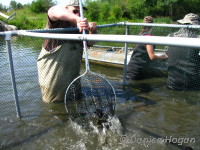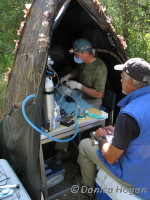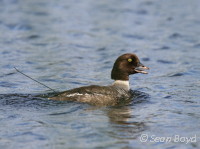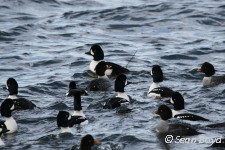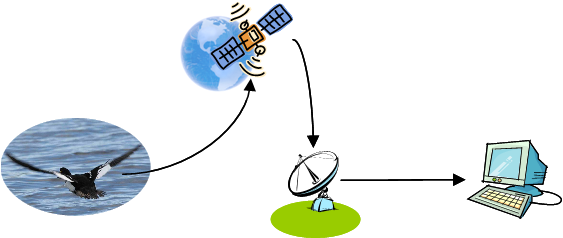| Birds were captured using a number of different techniques, as follows: |
| Floating mist nets: | Adult males and females on wintering grounds (Indian Arm, BC, and Juneau and Prince William Sound, AK). | | Underwater gill nets: | Adult males on breeding grounds (Riske Creek, BC). | | Drive traps: | Adult females and hatch-year birds on breeding grounds (Riske Creek, BC).
Adult males on molting grounds (Cardinal
Lake, AB). |
| Each
bird was implanted with a small (26g - 38g) satellite transmitter (PTT)
into the abdominal cavity
by a trained veterinarian using standard surgical techniques. The PTT
transmitted individual location, temperature, and battery voltage data
until the
bird died or the battery failed. Data were downloaded automatically, stored, and eventually analyzed using ArcGIS (ESRI
2008-2010) to map movements and connectivity. For data processed up to
November 2009, only the highest quality location data
were used
(Argos Classes 3, 2 and 1), except in cases where extended data gaps
existed. Data processed after the above date were filtered using the
Douglas Argos Filter Algorithm prior to analysis in ArcGIS. |
The fate
of each marked BAGO was determined using temperature and voltage data. The graphs below illustrate the 4 possible
fates for data processed in August
2010:
* click graph to enlarge as .pdf in this window |
| Bird died | Battery Failed | Transmissions stopped
(reason unknown) | PTT still transmitting | 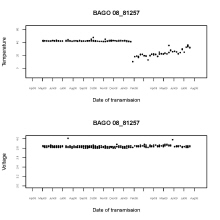 | 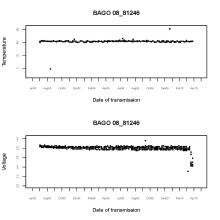 | 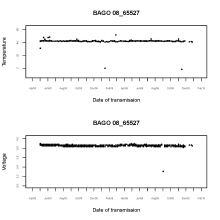 | 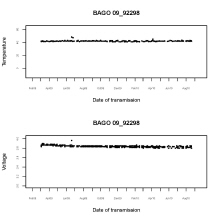 |
| We
identified breeding, molting, wintering, staging and stopover sites for each individual
using the criteria below, which were developed based on
exploratory analysis of known sites, and findings published in other
studies: |
| Breeding | Molting | Breeding + Molting
(same site) | Wintering | Staging | Stopover | 1. Stay for >= 14 days
2. Arrive between Apr - May
3. Depart between May - Jul
4. Not a HY bird in its 1st year after hatching | 1. Stay for >= 21 days
2. Arrive between May - Aug
3. Depart between Sept - Nov
4. Does not meet criteria for breeding + molting | 1. Stay for >= 35 days
2. Arrive between Apr - May
3. Depart between Sept - Nov
4. Does not have an independent breeding site identified | 1. Month = Dec, Jan or Feb (no constraints on distance)
2. Months = Nov, Mar or Apr AND movements are <=100km.
ģIf a movement of >100km is identified, then this
indicates that the bird is either still on fall (Nov) or has started
spring (Mar, Apr) migration and all points before (Nov) or after (Mar, Apr) are labeled fall or spring staging respectively. | Any site where the bird stops for > 7 days and that does not qualify as breeding, molting, or wintering. | Any site where the bird stops for 2 to 7 days. |
| Data are still being generated, and more birds will be marked in the future. Hence,
the maps included on this website will be updated periodically, until such time as all PTTs are no longer
transmitting. The entire project will be written up once the last PTT has stopped transmitting. |
|
